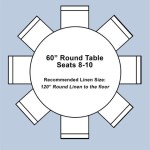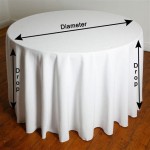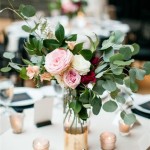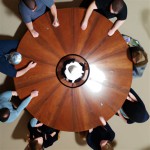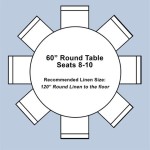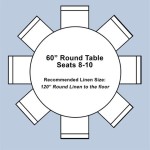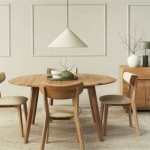What Size Square Overlay for 72" Round Table Tops
Determining the appropriate size of a square overlay for a 72-inch round table top requires careful consideration of several factors, including the desired aesthetic, functional requirements, and the event's overall style. Overlays serve multiple purposes: they can protect the table linens beneath, add a decorative element with color and texture, and delineate seating arrangements. Selecting the right overlay size ensures that the table presentation is both visually appealing and practical for guests.
The base measurement of 72 inches refers to the diameter of the round table. This means the distance across the circle, passing through the center point, is 72 inches. When choosing a square overlay, the dimensions relate to the length of each side of the square. The objective is to select a square dimension that allows for the desired amount of "drop" or overhang on all sides of the round table. This drop is the portion of the overlay that extends beyond the edge of the table and contributes to the overall visual impact.
The following sections will discuss key considerations for determining the ideal square overlay size for a 72-inch round table, exploring varying drop lengths and their respective effects on the overall table setting.
Understanding Drop Length and Visual Impact
The "drop" of an overlay refers to the distance the fabric hangs down from the edge of the table. This measurement significantly influences the appearance of the table setting. Different drop lengths create vastly different aesthetics, and the choice depends largely on the formality and style of the event. Common drop lengths range from a minimal 6-inch drop to a full "pooling" drop that reaches the floor.
A shorter drop, such as 6 to 12 inches, provides a clean and contemporary look. This option is suitable for less formal events or when showcasing the tablecloth underneath. It's a practical choice when minimizing fabric around the table is desired, preventing guests from accidentally stepping on or tangling with the overlay.
A medium drop, typically between 15 and 24 inches, offers a balance between elegance and practicality. This length is often used for semi-formal events, providing a noticeable drape without overwhelming the table. It's a versatile choice that works well with various table settings and centerpieces.
A longer drop, ranging from 27 to 30 inches, creates a more formal and luxurious atmosphere. This length is often used for weddings, galas, and other upscale events. The extended fabric adds a dramatic element to the table setting and requires careful consideration of the fabric type and weight to ensure proper draping.
A "pooling" drop occurs when the overlay extends all the way to the floor and then gathers slightly on the ground. This style is the most formal and opulent, creating a sense of grandeur and sophistication. It requires precise measurements and the use of high-quality fabrics that drape beautifully. However, it is less practical in high-traffic areas or situations where cleanliness is a major concern.
Calculating the required square overlay size involves adding twice the desired drop length to the table's diameter. For example, if a 15-inch drop is desired on a 72-inch round table, the calculation would be: 72 inches (diameter) + 15 inches (drop) + 15 inches (drop) = 102 inches. Therefore, a 102-inch square overlay would provide the desired 15-inch drop on all sides of the table.
Fabric Choice and Drape Considerations
The fabric chosen for the overlay plays a crucial role in how it drapes and impacts the overall look. Different fabrics have varying weights, textures, and stiffness, all of which influence the final appearance.
Lighter fabrics, such as chiffon or voile, create a soft and flowing drape. These fabrics are often used for overlays with longer drops, as they naturally gather and pool gracefully on the floor. However, they may require more care and attention to ensure they are properly arranged and don't wrinkle easily.
Medium-weight fabrics, such as polyester or cotton blends, offer a balance between drape and durability. These fabrics are versatile and can be used for various drop lengths. They are also easier to care for and maintain compared to lighter fabrics.
Heavier fabrics, such as damask or brocade, create a more structured and formal drape. These fabrics are often used for overlays with shorter to medium drops, as they hold their shape well and add a touch of elegance to the table setting. However, they may not be suitable for longer drops, as they can appear bulky and less fluid.
The fabric's texture also affects the overall aesthetic. Smooth fabrics, such as satin or silk, create a sleek and sophisticated look. Textured fabrics, such as linen or burlap, add visual interest and depth to the table setting. The choice depends on the desired style and the event's overall theme.
Furthermore, the fabric's opacity should be considered. Sheer or semi-sheer fabrics allow the tablecloth underneath to be visible, creating a layered effect. Opaque fabrics completely cover the tablecloth, providing a solid block of color and texture. The choice depends on whether the tablecloth is intended to be part of the overall design or simply a protective layer.
Practical Considerations and Event Type
Beyond aesthetics, practical considerations must be factored into the decision-making process. The type of event, the venue layout, and the expected guest behavior all influence the ideal overlay size.
For events with limited space, a shorter drop may be preferred to prevent overcrowding and ensure ease of movement. This is particularly important in venues with narrow aisles or limited seating areas. A longer drop could become a tripping hazard or obstruct pathways, making it difficult for guests and staff to navigate the space.
In outdoor settings, the weather conditions should be considered. A longer drop may be susceptible to wind, causing the overlay to billow or lift, potentially disrupting the table setting. In such cases, a shorter or medium drop may be more practical. Alternatively, consider using weighted tablecloth clips to secure the overlay to the table.
The formality of the event also plays a significant role. Formal events, such as weddings and galas, often warrant longer drops and more luxurious fabrics. Casual events, such as birthday parties and picnics, may be better suited to shorter drops and more durable fabrics.
Consider the type of centerpieces being used. Large or elaborate centerpieces may benefit from a longer drop, which provides a more balanced and visually appealing backdrop. Smaller or simpler centerpieces may be better complemented by a shorter drop, which allows the centerpiece to stand out without being overshadowed by the fabric.
The overlay's primary function should also be considered. If the overlay is intended to protect the tablecloth underneath from spills and stains, a durable and stain-resistant fabric should be chosen. The size should be adequate to cover the entire table surface and provide sufficient protection. If the overlay is primarily decorative, the focus should be on the aesthetic appeal and the overall visual impact.
Ultimately, the ideal square overlay size for a 72-inch round table top depends on a balance of aesthetic preferences, functional requirements, and the specific event context. Careful consideration of these factors will ensure that the chosen overlay enhances the overall table setting and contributes to a successful and memorable event.

Table Overlays Sizing Guide Balsa Circle Blog Balsacircle Com

Table Linen Overlay Size Chart For 5 6 Round Tables Collective Event Group

Table Overlays Sizing Guide Balsa Circle Blog Balsacircle Com

72 X Overlay Barrons

How To Choose The Right Table Overlay Size For Your Wedding

Cv Linens Square 72 Satin Table Overlay Red

Overlays Measurements

How To Choose The Right Table Overlay Size For Your Wedding

Classic Events And Parties

Table Overlays Sizing Guide Balsa Circle Blog Balsacircle Com
Related Posts


